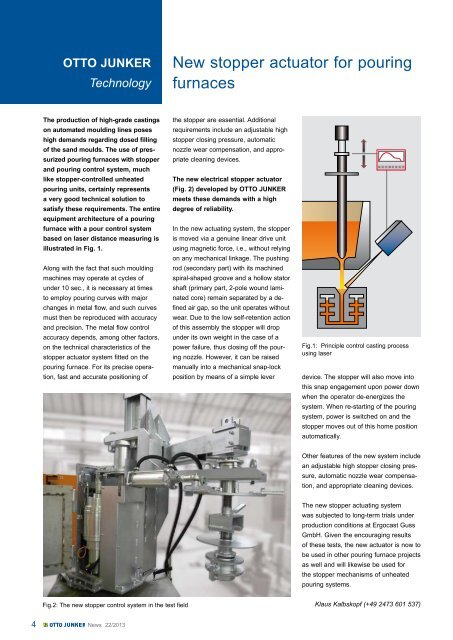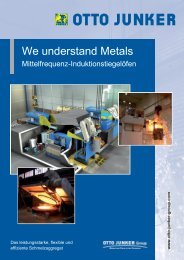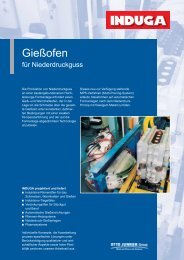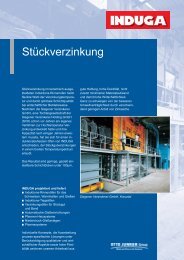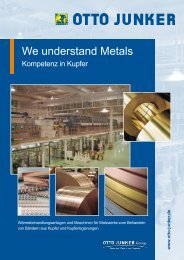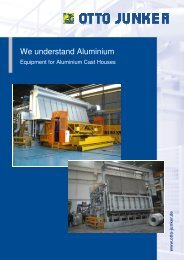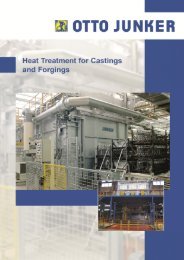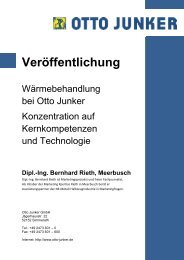You also want an ePaper? Increase the reach of your titles
YUMPU automatically turns print PDFs into web optimized ePapers that Google loves.
OTTO JUNKER<br />
Technology<br />
New stopper actuator for pouring<br />
furnaces<br />
The production of high-grade castings<br />
on automated moulding lines poses<br />
high demands regarding dosed filling<br />
of the sand moulds. The use of pressurized<br />
pouring furnaces with stopper<br />
and pouring control system, much<br />
like stopper-controlled unheated<br />
pouring units, certainly represents<br />
a very good technical solution to<br />
satisfy these requirements. The entire<br />
equipment architecture of a pouring<br />
furnace with a pour control system<br />
based on laser distance measuring is<br />
illustrated in Fig. 1.<br />
Along with the fact that such moulding<br />
machines may operate at cycles of<br />
under 10 sec., it is necessary at times<br />
to employ pouring curves with major<br />
changes in metal flow, and such curves<br />
must then be reproduced with accuracy<br />
and precision. The metal flow control<br />
accuracy depends, among other factors,<br />
on the technical characteristics of the<br />
stopper actuator system fitted on the<br />
pouring furnace. For its precise operation,<br />
fast and accurate positioning of<br />
the stopper are essential. Additional<br />
requirements include an adjustable high<br />
stopper closing pressure, automatic<br />
nozzle wear compensation, and appropriate<br />
cleaning devices.<br />
The new electrical stopper actuator<br />
(Fig. 2) developed by OTTO JUNKER<br />
meets these demands with a high<br />
degree of reliability.<br />
In the new actuating system, the stopper<br />
is moved via a genuine linear drive unit<br />
using magnetic force, i.e., without relying<br />
on any mechanical linkage. The pushing<br />
rod (secondary part) with its machined<br />
spiral-shaped groove and a hollow stator<br />
shaft (primary part, 2-pole wound laminated<br />
core) remain separated by a defined<br />
air gap, so the unit operates without<br />
wear. Due to the low self-retention action<br />
of this assembly the stopper will drop<br />
under its own weight in the case of a<br />
power failure, thus closing off the pouring<br />
nozzle. However, it can be raised<br />
manually into a mechanical snap-lock<br />
position by means of a simple lever<br />
Fig.1: Principle control casting process<br />
using laser<br />
device. The stopper will also move into<br />
this snap engagement upon power down<br />
when the operator de-energizes the<br />
system. When re-starting of the pouring<br />
system, power is switched on and the<br />
stopper moves out of this home position<br />
automatically.<br />
Other features of the new system include<br />
an adjustable high stopper closing pressure,<br />
automatic nozzle wear compensation,<br />
and appropriate cleaning devices.<br />
The new stopper actuating system<br />
was subjected to long-term trials under<br />
production conditions at Ergocast Guss<br />
<strong>GmbH</strong>. Given the encouraging results<br />
of these tests, the new actuator is now to<br />
be used in other pouring furnace projects<br />
as well and will likewise be used for<br />
the stopper mechanisms of unheated<br />
pouring systems.<br />
Fig.2: The new stopper control system in the test field<br />
Klaus Kalbskopf (+49 2473 601 537)<br />
4<br />
News 22/2013


